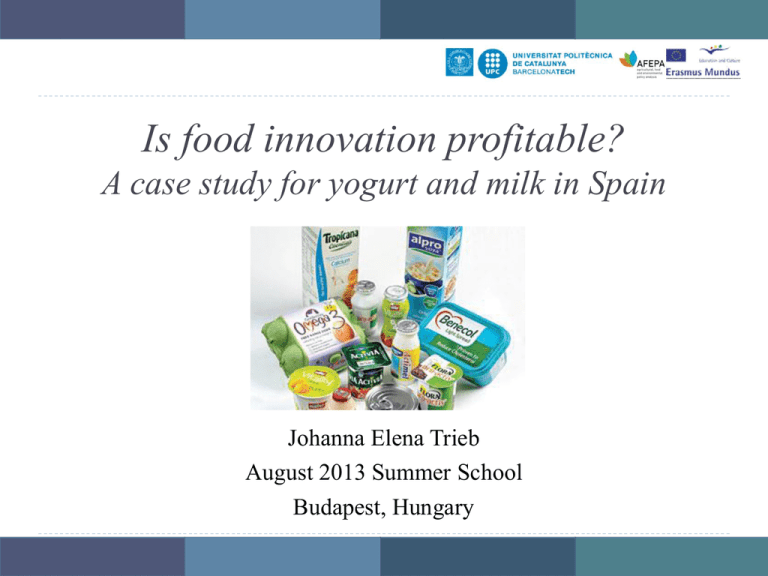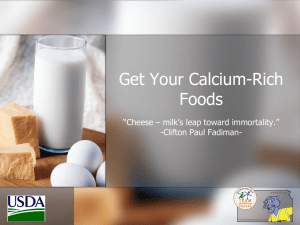Is food innovation profitable? A case study for yogurt and milk in Spain
advertisement

Is food innovation profitable? A case study for yogurt and milk in Spain Johanna Elena Trieb August 2013 Summer School Budapest, Hungary FDI and Food Innovation In 2006, global food and drink industry (FDI) retail sales > 2 trillion US$, representing one of largest industries in the world (Winger and Wall, 2006) 10-14% of total hh expenditure (high income) and 40-50% of total hh expenditure (low income) spent on food (Winger and Wall, 2006) Growing world population, increase in urbanization, increasing environmental concerns, changes in lifestyle will require the FDI to keep up Innovation is generally an important driver of economic growth, and in the FDI will continue to be important to ensure the sustainability of manufacturers and satisfaction of consumers New product development Currently, only 1% of the products found on shelves will be there in 5 years…(Winger and Wall, 2006) Many types of new food products: new to the market, new to the company, new packaging, reformulating of existing products In general: incremental (re-development of existing) vs radically novel Functional food “if together with the basic nutritional impact it has beneficial effects on one or more functions of the human organism thus either improving the general and physical conditions and/or decreasing the risk of the evolution of diseases” (EC) Percentage of Functional Claims in World Market 50 45 40 35 30 25 20 15 10 5 0 Source: adapted from Jago. 2009 The FF market Food Classes with Functional Claims in World Market Dairy Products 2% 3% Share of Global Functional Foods Market (2003) 2% Alcohol-free beverages 2% 8% Childrens Food 4% Others 4% 35% Baked food 5% 46% 5% Snacks 25% Europe Breakfast Cereals Japan Chewing Gum 6% Rest of World Desserts and Ice Cream 21% Sauces and Dressings Processed Fish, Meat, Eggs United States 32% Source: adapted from Giannetti et al. 2009 Source: adapted from Kotilainen et al., 2006 46% of FF are dairy products (Jago, 2009), brought 1.35 billion US$ in Europe in 1999 (Benkouider, 2005), mainly pro (lactobacillus/bifidus) and prebiotics Probiotics = 5 mill to 419 mill US$ from 1995 to 2000 (5 years) in Germany alone (yogurt and milk) (Menrad, 2003) Global FF market estimated revenue 33-48 billion US$ in 2003 (depending on definition) (Menrad, 2003) European market was estimated between 8 and 15 billion US$ in 2003 and 2006, respectively (Menrad, 2003; Kotilainen et al. 2006) Germany, France, UK, Netherlands The cost of innovation Steps in NPD develop strategy design and production commercialization & launch BUT: high costs associated with NPD (technologies, investment in R&D; scientific and market research), especially in case of FF Cost of development of new food 1-2 mill US$, Unilever invested over 50 milll US$ to develop functional margarine Becel(Menrad, 2003) high risks (Relatively high market failure rate, 25% of innovative food products fail)(Hoban, 1998) Most important to prevent failure of the product = consumer acceptance Objective of this study Analyze consumer demand of various categories of innovative food products (ie conventional vs reduced fat vs functional) in Spain to study possible differences in purchasing behavior and ultimately determine potential profitability of food innovation Data Model Results Discussion Procedure 1) Choose product(s) and categories 2) Find appropriate demand model to calculate expenditure and price elasticities 3) Analyze influence of demographic variables Source: own graphical depiction Data Data Set Daily retail scanner data from a major discount supermarket chain in Spain 4-month period (July 1, 2011 – October 31, 2011) Focus on Madrid and Barcelona, 17 stores Customers according to Residence % Customers Source:adapted from Cataño, 2013 Data Product Choice Unflavored Normal Whole Milk Milk Consumption 2% 1% 5% Unsalted Butter 7% Low-fat Milk Enriched 25% Whole Milk without Lactose Low-fat Milk wo Lactose 17% 31% 6% 37% 20% Flavored Milk&Drinks Unflavored Normal Soja Milk Salted Butter 19% Non-fat Milk wo Lactose 6% Joghurt (&Drinks) Consumption Butter/Margarine Consumption Unflavored Normal Low-fat (semi) Milk Whole Milk Enriched (Calcium, Fiber, Energy, Bifidus, Omega3) Non-fat Milk Enriched 2% 6% 5% Unflavored Normal Non-fat Milk 4% Flavored Soja Milk 3% Normal Joghurt (Whole&Non-fat) 7% Normal Mayonnaise Joghurt Drinks 37% Mayonnaise with Olive Oil 29% Bifidus Joghurt + Drinks (Whole&Non-fat) 14% Light Mayonnaise Lactobacillus Joghurt + Drinks (Whole&Non-fat) 24% Greek Joghurt 7% Low-Sugar Mayonnaise 64% Margarine Light Enriched Margarine (Omega3, Vitamins, Proactive, Gourmet) Olivespread-Margarine 7% Unflavored Normal Low-fat (semi) Soja 2% 11% Normal Margarine Salted Margarine Mayonnaise Consumption Other (with Mustard) 2% Other (Mouse, Creams, Dessert Joghurt, Soja, Babies) Soja Milk Enriched with Calcium 20493* 182404* 243724* Breakfast Cereal Consumption Egg Consumption 2% 0,003% 13% 41% 44% 21% Eggs L Sweetened Kids Breakfast Cereal (Sugar, Honey, Chocolate) Eggs M Unsweetened Breakfast Cereals Freerange Eggs M Eggs Enriched w Omega-3 28% 51% Fruit, Fiber, All-bran Breakfast Cereals Sugar/Sweetener Consumption Canned Tuna Consumption 1%1% 10% 1% Eggs XL 21975* Canned Tuna in Water/Natural 14% Canned Tuna in Olive Oil 27% 5% Canned Tuna in Vegetable Oil 5% 8% White Sugar Brown Sugar Canned Tuna in Sauce 46% Canned Tuna in Water Low Salt Sweetener Solid 82% Sweetener Liquid Canned Tuna in Olive Oil Low Salt Other (Tuna Belly, Tunameatballs, pickled Tuna) 71021* 29022* 55588* 35940* *purchases Source: own calculations Data Yogurt consumption Total Yogurt Expenditure Total Expenditure by Category (in 1000€) Gender Distribution Consumer Age Range 80 14% 38% 22% Drinkable 241 (18%) 70 Female Male Enriched Whole-fat Low-fat 26% 1088 (82%) 2% 13.42 60 34% 50 7.74 40 30 20% 8.33 61.00 43.51 20 Male Female 18-25 26-40 41-60 61-95 44% 4.92 33.59 21.41 10 0 Drinkable Enriched Low-fat Whole-fat Source: own calculations Data Fluid milk consumption Total Milk Expenditure Gender Distribution Total Expenditure by Category Consumer Age Range 4000 3% 3500 27% 21% 28% 24% Enriched Semi-skim Skim Whole 71 (23%) 3000 Female 729 939 878 2500 Male 236 (77%) 41-60 Male 2707 1000 2887 2346 18-25 26-40 2000 1500 21% 31% 683 61-92 Female 45% 2117 500 0 Enriched Semi-skim Skim Whole Source: own calculations Research Questions and Hypotheses RQ1: Are there differences in the price/expenditure elasticities of demand between the various categories? RQ2: Are there potential differences between products? H1: Low-fat more inelastic in demand than whole-fat; functional food demand more inelastic than conventional; enriched and drinkable more expenditure elastic than conventional H2: Expect comparable changes in demand with changes in price/expenditure for milk and yogurt. RQ3: Do age and gender influence demand of innovative food products? H3: Age and gender play a role in demand of FF (since majority of studies show for example that females and consumers over 60 years have increased demand in FF) (Urala and Lähteenmäki, 2007) Model Model specification: QUAIDS x wi i ij log p j i log i a( p) j 1 Restrictions Adding up: x i x w i i ij ln p j i ln ln i a( p) b( p) a( p) j 1 k k k b( p) pi i where wi piqi x i 0 i1 k ij i 0 i1 Homogeneity: k k ij Symmetry: ij ji is the expenditure share for good i pi is the average price of good i = 1….k (4), x the total expenditures on yogurt/milk When i 0i the quadratic income term in each expenditure share falls away = QUAIDS = AIDS 0 j 1 k i1 i1 1 2 1 lna(p) 0 i ln pi ij ln pi ln p j 2 i1 j 1 i1 i i1 k (Banks et al., 1997) k k Quadratic AIDS (QUAIDS) k (Deaton and Muellbauer, 1980) k Almost Ideal Demand System (AIDS) Demographics age and a gender dummy were included via a demographic scaling technique j 1 ij 0 Model Expenditure and Price elasticities Expenditure Elasticities Uncompensated (Marshallian) Price Elasticities Compensated (Hicksian) Price Elasticities Results Descriptive statistics & Wald-test Source: own calculations Results Expenditure Elasticities Increase in consumer expenditure results in greater increase in expenditure on drinkable and enriched yogurt (above unity; luxury) than low- or whole-fat (necessity) Low-fat greater expenditure elasticity (near unity) than wholefat yogurt (Davis et al 2010, normal nondrinkable yogurt 0.998 vs 1.000 drinkable) Again, increase in consumer expenditure results in greater increase in expenditure on enriched/functional milk (above unity; luxury) compared to skim- or whole-fat milk (necessity) Again, skim-fat greater expenditure elasticity (near unity) than whole-fat yogurt (Glaser and Thompson, 2000; Dhar and Foltz, 2004; Li et al 2012) Note: conditional (wrt total yogurt/milk expenditures) Source: own estimation results Results Uncompensated Price Elasticities Yogurt: all relatively inelastic. Enriched functional yogurt most sensitive to price changes (Bonnano, 2009: functional drinkable yogurt more sensitive than conventional). Low-fat yogurt demand most inelastic. Whole-fat yogurt more sensitive than low-fat (Bonnano, 2009). Drinkable less sensitive than enriched, whole-fat (Davis et al., 2010: drinkable -1.103, refrigerated – 1.012) Milk: Enriched and semi-skim demand more inelastic than skim and whole. Whole-fat more elastic than low-fat. Contradicts with yogurt where enriched was most sensitive to price changes. But Di Giacomo 2008 showed than functional drinkable yogurt more inelastic than conventional drinkable. Source: own estimation results Results Compensated Price Elasticities Yogurt: All compensated smaller in value than uncompensated (consumer shld have same utility before and after price increase; consumer gets “compensated” for price increase with rise in income); thus effect will be less severe. Since different suggests that the income effect on demand is significant. CPE positive = substitutable products. Drinkable and enriched demand more inelastic than low and whole-fat yogurt (Davis et al., 2010: -0.159 drinkable, -0.605 conventiional). Again, whole-fat more elastic than low-fat (Milk studies: Boehm, 1975; Gould, 1996 (-0.803 whole, -0.593 1%/skim)) Milk: Again, low-fat less sensitive to price changes than whole-fat. Enriched though insignificant, appears most inelastic. Source: own estimation results Demographic variables Yogurt: Increase in age increases demand for drinkable yogurt, decreases demand for low-fat yogurt Gender (female) influences demand of whole-fat yogurt negatively Milk: Gender positive and significant impact on semi-skim milk demand (Females increased demand) Discussion Discussion Based on this study, would be “un-academic” to assume that investing in development of functional products is profitable But; suggest that functional yogurt and milk products in Madrid and Barcelona in general are relatively inelastic in demand. Also low-fat varieties in both cases appear less sensitive to price changes than whole-fat varieties Further and continuous consumer demand/market research crucial… Discussion Limitations and Future considerations Larger data set, ie including retail scanner data from other supermarket to get full overview Longer time period, to decrease probability of zero-consumption and analyze possible seasonal effects Further disaggregation of the products (by functionality and fat-level, flavored or plain) Look at more products Conditional (wrt to yogurt/milk expenditure) vs Unconditional (wrt to total food expenditure) to take direct and indirect effects of price changes on yogurt/milk demand into account; conditional will likely be larger in absolute value than unconditional… Analyze influence of further demographic characteristics on demand presence, number and age of children; education, labeling advertising household income References Annunziata, A. & Vecchio, R. (2010). Italian Consumer Attitudes Toward Products for Well-being: The Functional Foods Market. International Food and Agribusiness Management Review, 13(2), 19-50. Banks, J., Blundell, R., & Lewbel, A. (1997). Quadratic Engel Curves and Consumer Demand. The Review of Economics and Statistics, 79(4), 527-539. Bech-Larsen, T. & Grunert, K.G. (2003). The perceived healthiness of functional foods—A conjoint study of Danish, Finnish and American consumers’ perception of functional foods. Appetite, 40, 9–14. Bech-Larsen, T. & Scholderer, J. (2007). Functional foods in Europe: Consumer research, market experiences and regulatory aspects. Trends in Food Science & Technology, 18, 231–234. Bellisle, F. (1998). Functional Food Science in Europe – Theme Papers. British Journal of Nutrition, 80(1), 1-193. Benkouider, C. (2005). The world’s emerging markets. Functional Foods and Nutraceuticals. http://www.ffnmag.com/NH/ASP/strArticleID/770/strSite/FFNSite/articleDisplay.asp. Boehm, T.W. (1975). The Household Demand for Major Dairy Products in the Southern Region. Southern Journal of Agricultural Economics, 7(2), 187-196. Bonanno, A. (2009). Some like it healthy: demand for functional products in the Italian yogurt market. Paper prepared for the 113 th EAAE Seminar “A resilient European food industry and food chain in a challenging world” Chania, Crete, Greece, September 3-6, 2009. Cataño Olmos, E. (2013). Analisis del Comportamiento de Compra de los Consumidores Españoles en el Sector de la Gran Distrubución. Centro de Investigacion en Economía y Dessarolla Agroalimentario, Barcelona. Davis, C., Blayner, D., Muhammd, A., Yen, S.T., & Cooper, J. (2010). A Cross-Sectional Analysis of U.S Yogurt Demand. Journal of Food Distribution Research, 41(2), 36-45 Deaton, A. & Muellbauer, J. (1980a). An Almost Ideal Demand System. The American Economic Review, 70(3), 312-326. Deaton, A. & Muellbauer, J. (1980b). Economics and Consumer Behavior. Cambridge University Press, USA. Dhar, T. & Foltz, J.D. (2004). Is Soy Milk? The Economics of the Soy Milk Market. Selected Paper of American Agricultural Economics Association, Denver, CO, August 1-4, 2004. Di Giacomo, M. (2008). GMM estimation of a structural demand model for yogurt and the effects of the introduction of new brands. Empirical Economics, 34, 537– 565. Diplock, A.T. (1999). Scientific Concepts of Functional Foods in Europe – Consensus Document. British Journal of Nutrition, 81(1), 1-27. Glaser, L.K. & Thompson, G.D, (2000). Demand for Organic and Conventional Beverage Milk. Selected Paper of the Western Agricultural Economics Association, Vancouver, British Columbia, June 29-July 1, 2000. Giannetti, V., Testani E., & Recchia, L. (2009). Food Consumption and Innovation: Functional Foods. J. Commodity Sci. Technol. Quality, 48(3), 213-225. References continued.. Gould, B.W. (1996). Factors Affecting U.S. Demand for Reduced-Fat Fluid Milk. Journal of Agricultural and Resource Economics, 21(1), 68–81. Hoban, T. J. (1998). Improving the success of new product development. Food Technology, 52(1), 46-49. Jago, D. (2009). Functional foods, market trends. Functional foods symposium, Amsterdam, 2009. Kotilainen, L., Rajalahti, R., Ragasa, C., & Pehu, E. (2006). Health enhancing foods: Opportunities for strengthening the sector in developing countries. Agriculture and Rural Development Discussion Paper 30. World Bank. Martinez, M.G., & Briz, J. (2000). Innovation in the Spanish Food & Drink Industry. International Food and Agribusiness Management Review, 3, 155-176 Menrad, K. (2003). Market and marketing of functional food in Europe. Journal of Food Engineering, 56, 181–188. Monár, J. (2007). The Spanish functional food market: Present and future perspectives. European Functional Food Net (FFNet) network meeting, IATA-CSIC. Siró, I., Kápolna, E., Kápolna, B., & Lugasi, A. (2008). Functional food, Product development, marketing and consumer acceptance – A review. Appetite, 51, 456–467. Stewart-Knox, B. J., Vaz De Almeida, M. D., Parr, H., Pinhao, S., Bunting, B., & Gibney, M. (2007). Consumer uptake of functional foods in Europe. International developments in science & health claims, ILSI international symposium on functional foods in Europe. Urala, N. & Lähteenmäki, L. (2007). Consumers’ changing attitudes towards functional foods. Food Quality and Preference, 18, 1–12. Winger, R. & Wall, G. (2006). Food product innovation: A background paper. FAO Food and Agriculture Organization of the United Nations: Agricultural and Food Engineering document 2. Thank you for your attention!







